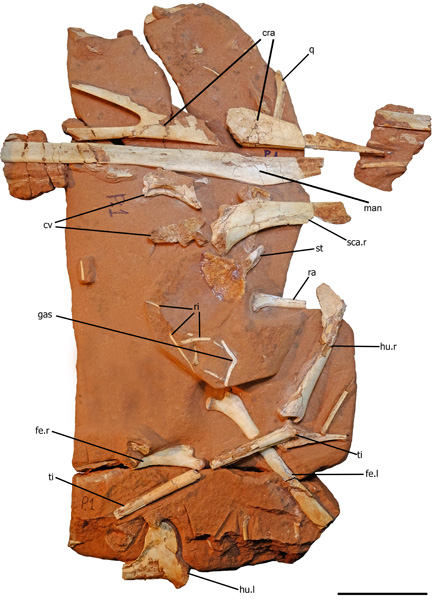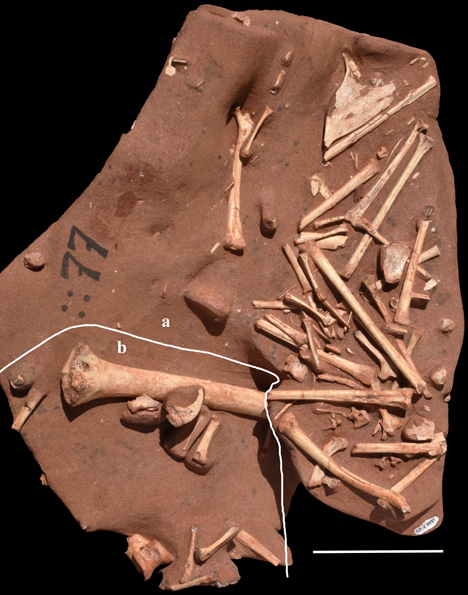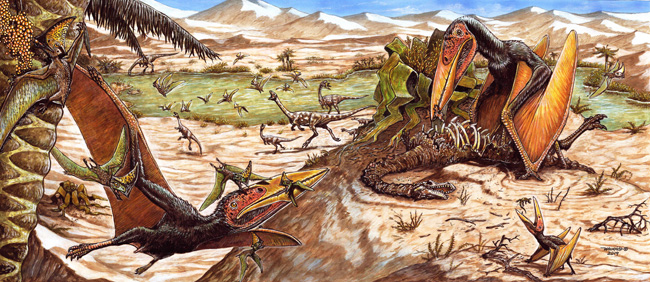New Brazilian Pterosaur Announced
Keresdrakon Lived Alongside Caiuajara
A new species of large, toothless pterosaur has been described based on fossil specimens excavated from the “cemitério dos pterossauros” (pterosaur graveyard), in southern Brazil. This new flying reptile has been named Keresdrakon vilsoni. The researchers, writing in the academic journal “Anais da Academia Brasileira de Ciências” conclude that Keresdrakon co-existed with another, smaller and, based on the fossil evidence more numerous, pterosaur (Caiuajara dobruskii). In addition, the two distinct pterosaurs coexisted with a theropod dinosaur (Vespersaurus paranaensis) and together they provide an unique insight into an ancient desert ecosystem.
The Palaeoenvironment of the “Cemitério dos Pterossauros”
Picture credit: Maurilio Oliveira
Interpreting the Palaeoenvironment
The age of the strata is disputed. Some authors favour a Turonian to Campanian age indicating Upper Cretaceous deposits, whilst other scientists have suggested that the rocks might be Lower Cretaceous in age (Aptian to Albian). The bonebeds associated with these sandstones indicate a congregation of vertebrates in what was probably an interdunal wetland in the middle of a desert. Caiuajara is interpreted as a likely frugivore, a feeding behaviour associated with other members of the Tapejaridae family. Although, the much larger, edentulous (toothless), Keresdrakon probably filled a different niche in the ecosystem. Its fossils are much rarer than those of Caiuajara, the researchers infer that Keresdrakon vilsoni might have behaved as an opportunistic predator or a scavenger.
Analysis of this pterosaur’s beak suggest that it did not have a strong bite, so overcoming larger prey such as the theropod Vespersaurus might have been difficult for Keresdrakon, but it could have fed on carrion, as depicted in the above illustration.
Keresdrakon vilsoni
The authors of the scientific paper, which include pterosaur expert Alexander Kellner of the Museu Nacional/Universidade Federal do Rio de Janeiro (Brazil), consider Keresdrakon to be the equivalent of a modern-day Marabou stork (Leptoptilos crumenifer), which scavenges but also eats any small animal that it can swallow.
The scientists speculate that K. vilsoni might have eaten juvenile Caiuajara or even hatchlings and eggs. Given the geological and fossil evidence, it is likely that these two pterosaurs along with Vespersaurus co-existed together and that the “cemitério dos pterossauros”, demonstrates evidence of sympatry in the Pterosauria, if this is the case, then these sandstone deposits of uncertain age in Paraná State represent an extremely significant discovery for vertebrate palaeontologists.
The Holotype Fossil Material of Keresdrakon vilsoni

Picture credit: Kellner et al
What is Sympatry?
Sympatry is a term used in biology to describe the situation when two or more related species co-exist in the same environment at the same time. Caiuajara and Keresdrakon are contemporaneous, occupying the same space and time in the fossil record.
To read about the discovery of Caiuajara dobruskii: New Species of Flying Reptile Identified from Pterosaur Graveyard.
To read about the theropod dinosaur associated with this fossil site: The First Dinosaur from the Caiuá Group – Brazil.
Classifying Keresdrakon vilsoni
A phylogenetic analysis suggests that Keresdrakon sits outside the Tapejaridae family but is still quite closely related to these types of flying reptiles. It is described as part of a non-tapejarid lineage within the wider Tapejaromorpha.
A Sandstone Block Showing Keresdrakon vilsoni and Caiuajara dobruskii Fossils in Association

Picture credit: Kellner et al
The scientific paper: “A new toothless pterosaur (Pterodactyloidea) from Southern Brazil with insights into the paleoecology of a Cretaceous desert” by Kellner, Alexander W. A.; Weinschütz, Luiz C.; Holgado, Borja; Bantim, Renan A. M.; Sayão, Juliana M. and published in the Anais da Academia Brasileira de Ciências.
Fly over to the Everything Dinosaur website: Everything Dinosaur.


